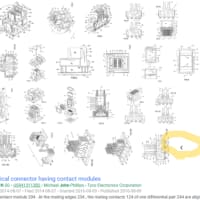WO2017040519
"Fig. 13 illustrates the use of head/face pose to computer generate 3D glance target vectors 1300. As shown in Fig. 13, a big 3D box 1302 is used to illustrate the cabin of the car. Additionally, a smaller 3D box 1304 inside the big 3D box 1302 represents a volume for the driver's head. The blue points 1306 inside the big 3D box 1302 represent the landmark points and the red points 1308 represent the glance target points according to the obtained head/face pose. As shown in Fig. 13, a majority of blue points 1306 construct a rough face including eyes, noses, and mouth and the majority of the red points 1308 indicate that the driver gazes forward of the car cabin 1302."
図13は、3Dの視線の対象ベクトル1300をコンピュータ生成するための頭部/顔の姿勢の使用を示している。図13に示すように、大きな3Dボックス1302を用いて車の室内を示す。さらに、大きな3Dボックス1302の中のより小さい3Dボックス1304は、運転手の頭部の体積を表す。大きな3Dボックス1302の中の青色点1306は器官点を表し、赤色点1308は取得された頭部/顔の姿勢による視線の対象点を表す。図13に示すように、青色点1306の大部分は、目、鼻、口を含む粗い顔を構成し、赤色点1308の大部分は、運転手が自動車の室内1302の前方を注視していることを示す。
US9134805
"For example, at the time information is being presented to the user by the electronic device, the user may be involved in some other activity that requires physical action, mental computation, or at least mental attention, that would render some types of presentation less effective than others. And the importance of performing that other activity may vary. For example, while driving a car, watching the road ahead is extremely important for safety reasons, and the distraction of a video presentation could be hazardous. On the other hand, looking at a video on the electronic device while sitting in front of a television would involve no safety issues."
例えば、電子機器がユーザに情報を提示する際に、ユーザが、物理的な動作、暗算、または少なくとも精神的な関心を必要とし、ある種類の提示方法の有効性を他の方法よりも低めるような別の動作に関与している場合がある。さらに、その別の動作を実行することの重要性は様々である。例えば、安全面の理由から、運転中に前方を注視することは非常に重要であり、動画の提示による邪魔は危険である。一方で、テレビの前で電子機器の動画を観ることは安全上の問題とはならない。
EP2380766
Figure 7 is an exemplary graphical representation of the detected yaw rate curve 16 in degrees/second over an arbitrary period of time during which operation is unimpaired. As can be appreciated from Figure 7 , spurious leads and lags in the yaw rate will also be detected. For example, an operator looking away from the forward road, and then correcting the accumulated error upon returning to a forward gaze, may cause a spurious lead or lag in the yaw rate when the operator corrects for an error in, for example, the travel path of the vehicle. This can be seen, for example, around the 45 second mark in Figure 7 . One or several spurious events will not result in the controller 14 identifying an impaired operation. However, a sequence of these spurious events in a short period of time could indicate ongoing inattention to the direction of travel, thus demonstrating impaired operation."
図7(a)は、任意の検出期間における正常運転状態でのヨーレイトの実測値(ヨーレイトカーブ16)を例示するグラフである。図7(a)の縦軸はヨーレイトを示し、図7(b)の縦軸は時間差を示し、図7(a)及び図7(b)の横軸は時間(秒)を示す。図7(a)及び図7(b)から分かるように、ヨーレイトカーブ16から擬似的な先行状態及び遅滞状態が検出される。例えば、運転者の視線が前方の道から外れ、前方を注視しながら蓄積された軌道修正を行うことにより、擬似的な先行状態或いは遅滞状態が車両走行中に軌道修正を行う際に発生する。図7(b)の45秒付近において、例えば、擬似的な遅滞状態が現れている。制御部14は、1回或いは複数回の擬似的な先行状態或いは遅滞状態から、異常運転状態を特定しない。しかし、短い期間中にこれらの擬似的な先行状態或いは遅滞状態が連続すれば、走行方向に対する注意が欠如し続けていることを示しているので、異常運転状態であることが明らかにされる。
US7235012
"FIGS. 6, 7A, 7B present a relatively simple scenario for a game and illustrate some of the features and advantages of the quick look button 28. FIG. 6 shows a plan view of playing field consisting of a main corridor 260 and two side corridors 262, 264 branching off from the main corridor. FIG. 7A describes the action of a player using the controller 100 to move a character through the corridor. The action starts in step 300. In step 302 the character C is shown on display 108 facing forward and walking down corridor 260 until point P1-the branch off point for corridor 262. At this point, the player stops the character C (step 304) and the player slides the button 28 to the right (step 306). This action causes the character to move its head to the right and the player is shown the scene seen by the character, i.e., corridor 262 (step 308). The player then clicks in the quick look button 28, releases it and starts the character C walking again up along corridor 260 (step 310). The character C keeps its head turned to the right (locked) as it walks straight and the player is shown the remaining part of corridor 262 (step 312). Once the character is past the corridor 262, the player stops walking and clicks in button 28 at its center or neutral position; the character's head returns to the central or neutral position to gaze straight ahead until point P2 (step 314)."
図6、図7A、及び図7Bは、ゲームの比較的単純なシナリオを示しており、クイックルックボタン28の幾つかの特徴及び利点を示している。図6は、ゲームの場面を示す平面図であり、当該場面は、主廊下260、及び当該主廊下から分岐する二つの片廊下262、264からなっている。図7Aは、コントローラ100を使用してキャラクタを廊下において移動させるプレーヤのアクションを示している。アクションは、ステップ300で開始する。ステップ302では、キャラクタCが、廊下262への分岐点である地点P1まで前方を向いて廊下260を歩いているように、ディスプレイ108上に表示される。この地点で、プレーヤが、キャラクタCを停止させ(ステップ304)、ボタン28を右にスライドする(ステップ306)。このアクションによって、キャラクタはその頭部を右へ移動し、プレーヤには、キャラクタによって見られているシーン、即ち、廊下262が示される(ステップ308)。プレーヤは、次いで、クイックルックボタン28をクリックし、当該ボタン28を解放して、キャラクタCに、廊下260に沿って再び歩行を開始させる(ステップ310)。キャラクタCは、真っ直ぐに歩きつつ頭部を右に回転させた状態を維持し(固定し)、そして、プレーヤには、廊下262の残りの部分が示される(ステップ312)。キャラクタが廊下262を通り過ぎると、プレーヤは歩行を停止させて、ボタン28をその中心位置、即ち中立位置においてクリックインし、キャラクタの頭部は、地点P2まで前方を注視するために、中心、即ち中立位置に戻される(ステップ314)。
最新の画像[もっと見る]
-
 DAZN(ダゾーン):メール配信停止ボタンくらい付けとけ
3日前
DAZN(ダゾーン):メール配信停止ボタンくらい付けとけ
3日前
-
 DAZN(ダゾーン):メール配信停止ボタンくらい付けとけ
3日前
DAZN(ダゾーン):メール配信停止ボタンくらい付けとけ
3日前
-
 バズリクソンズA2:第15週
6日前
バズリクソンズA2:第15週
6日前
-
 バズリクソンズA2:第14週
2週間前
バズリクソンズA2:第14週
2週間前
-
 Google Patents Advanced Searchで全部表示される図面の表示を隠す
2週間前
Google Patents Advanced Searchで全部表示される図面の表示を隠す
2週間前
-
 召合せ框(めしあわせかまち)
3週間前
召合せ框(めしあわせかまち)
3週間前
-
 バズリクソンズA2:第13週
3週間前
バズリクソンズA2:第13週
3週間前
-
 バズリクソンズA2:第13週
3週間前
バズリクソンズA2:第13週
3週間前
-
 バズリクソンズA2:第13週
3週間前
バズリクソンズA2:第13週
3週間前
-
 バズリクソンズA2:第12週
3週間前
バズリクソンズA2:第12週
3週間前
















※コメント投稿者のブログIDはブログ作成者のみに通知されます